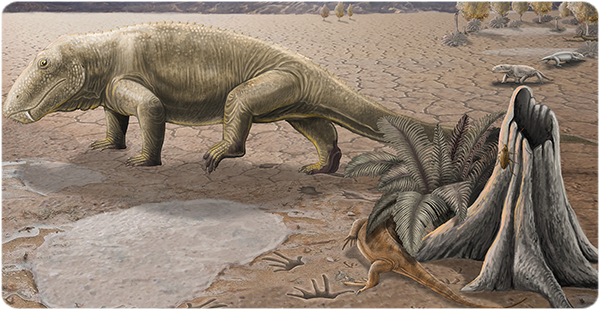 A study led by researchers from the Institut Català de Paleontologia Miquel Crusafont published in Palaeogeography, Palaeoclimatology, Palaeoecology describes the environmental and faunal changes that took place between 290 and 270 million years ago in the current region of Berguedà (Catalonia, North-East Spain). The Permian sedimentary deposits in this area reveal a transition from a landscape with rivers and floodplains to a more arid environment with a monsoonal regime. In parallel, the fossil footprint record indicates a faunal shift where amphibians disappeared.
A study led by researchers from the Institut Català de Paleontologia Miquel Crusafont published in Palaeogeography, Palaeoclimatology, Palaeoecology describes the environmental and faunal changes that took place between 290 and 270 million years ago in the current region of Berguedà (Catalonia, North-East Spain). The Permian sedimentary deposits in this area reveal a transition from a landscape with rivers and floodplains to a more arid environment with a monsoonal regime. In parallel, the fossil footprint record indicates a faunal shift where amphibians disappeared.
Un estudi publicat a la revista Palaeogeography, Palaeoclimatology, Palaeoecology encapçalat per personal investigador de l’Institut Català de Paleontologia Miquel Crusafont descriu els canvis ambientals i faunístics que es van produir fa entre 290 i 270 milions d’anys, a l’actual Berguedà (Catalunya). Els dipòsits sedimentaris del Permià d’aquesta zona mostren una transició des d’un paisatge amb rius i planes d’inundació a un ambient més àrid de règim monsònic. Paral·lelament, el registre d’icnites fòssils mostra un canvi faunístic on els amfibis van desaparèixer.

Researchers from the Universitat Autònoma de Barcelona (UAB) and the Institut Català de Paleontologia Miquel Crusafont (ICP), have discovered in Vallcebre (Barcelona) an impression fossil with the surface of the skin of a dinosaur from the Late Cretaceous, a period right before their extinction. Its characteristics make it a unique discovery in Europe. The finding has been published in the Geological Magazine.






